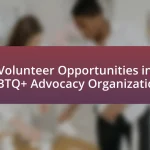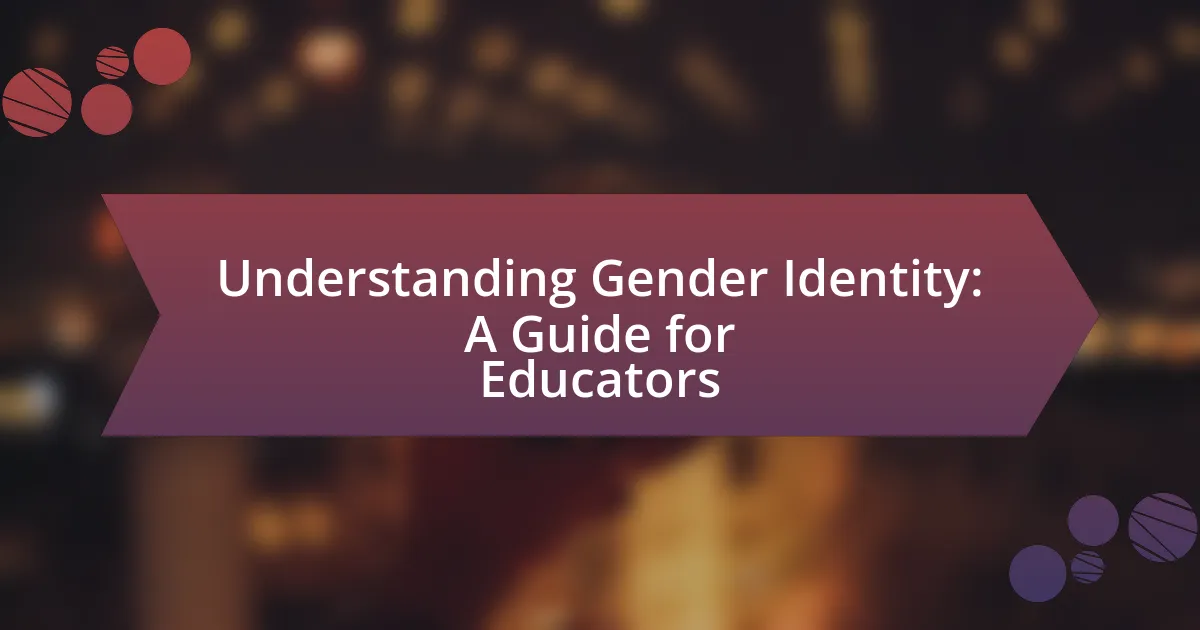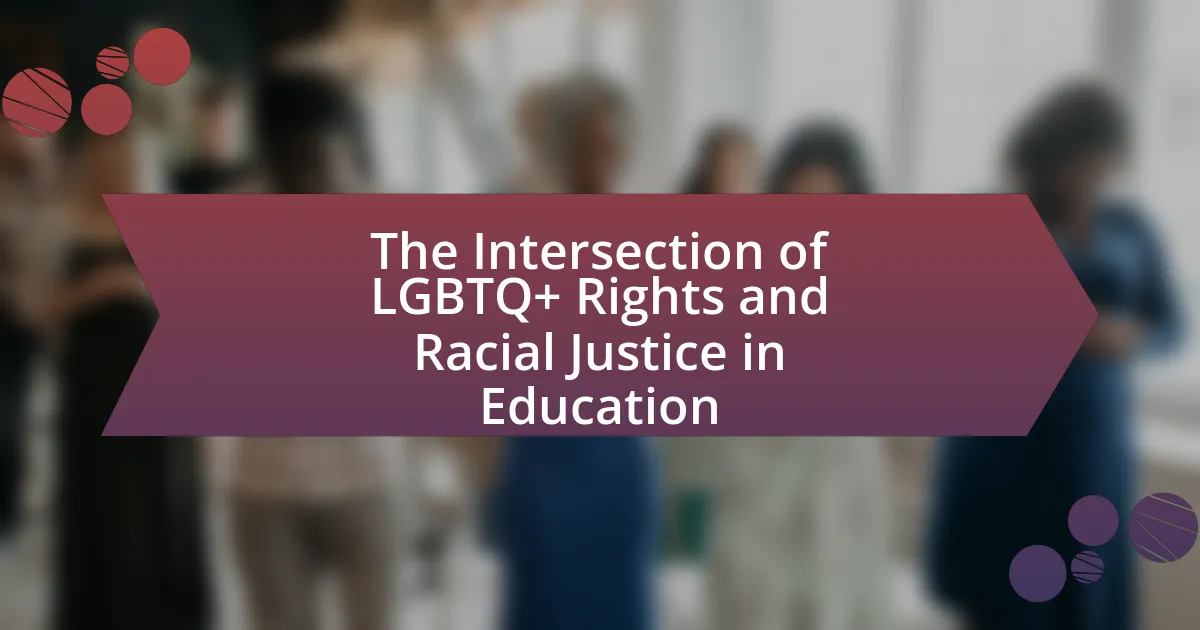The article “Addressing Misconceptions: LGBTQ+ Terminology Explained” provides a comprehensive overview of key terms and concepts within the LGBTQ+ community, including definitions of lesbian, gay, bisexual, transgender, queer, intersex, asexual, and ally. It emphasizes the significance of the acronym LGBTQ+ and the importance of the plus sign in representing diverse identities. The article addresses common misconceptions about these terms, the impact of stereotypes, and the evolution of LGBTQ+ terminology over time, highlighting the role of activism in shaping language. Additionally, it offers guidance on respectful engagement with LGBTQ+ terminology and resources for further education.

What are the key terms in LGBTQ+ terminology?
Key terms in LGBTQ+ terminology include lesbian, gay, bisexual, transgender, queer, questioning, intersex, asexual, and ally. These terms represent various sexual orientations, gender identities, and experiences within the LGBTQ+ community. For instance, “lesbian” refers to women who are attracted to other women, while “gay” typically describes men attracted to men. “Bisexual” indicates attraction to more than one gender, and “transgender” refers to individuals whose gender identity differs from the sex assigned at birth. “Queer” is an umbrella term for diverse sexual orientations and gender identities, and “questioning” describes individuals exploring their sexual orientation or gender identity. “Intersex” refers to individuals born with physical sex characteristics that do not fit typical definitions of male or female. “Asexual” describes those who experience little to no sexual attraction, and “ally” refers to individuals who support the LGBTQ+ community. Understanding these terms is crucial for fostering inclusivity and respect.
How do we define LGBTQ+?
LGBTQ+ is an acronym that stands for Lesbian, Gay, Bisexual, Transgender, and Queer or Questioning, with the plus sign (+) representing other sexual orientations and gender identities not specifically included in the initial letters. This definition encompasses a diverse range of identities, reflecting the complexity of human sexuality and gender. The inclusion of the plus sign acknowledges the existence of additional identities such as intersex, asexual, and non-binary individuals, among others, which are part of the broader spectrum of sexual and gender diversity.
What does each letter in LGBTQ+ stand for?
LGBTQ+ stands for Lesbian, Gay, Bisexual, Transgender, and Queer/Questioning, with the plus sign representing other sexual orientations and gender identities. Each letter defines a specific group within the broader spectrum of sexual orientation and gender identity. For instance, “Lesbian” refers to women who are attracted to other women, “Gay” typically refers to men attracted to men, “Bisexual” describes individuals attracted to both men and women, “Transgender” encompasses those whose gender identity differs from the sex assigned at birth, and “Queer/Questioning” includes those who identify as non-heteronormative or are exploring their sexual orientation or gender identity. The inclusion of the plus sign acknowledges the diversity of identities beyond these five categories, such as intersex, asexual, and others, reflecting the complexity of human sexuality and gender.
Why is the plus sign (+) significant in LGBTQ+ terminology?
The plus sign (+) is significant in LGBTQ+ terminology because it represents inclusivity of diverse sexual orientations, gender identities, and expressions beyond the initial acronym. The LGBTQ+ acronym traditionally includes lesbian, gay, bisexual, transgender, and queer or questioning individuals, but the plus sign acknowledges the existence of other identities such as intersex, asexual, pansexual, and more. This inclusion reflects the evolving understanding of gender and sexuality, emphasizing that the community encompasses a wide range of experiences and identities that cannot be fully captured by a limited set of letters.
What are common misconceptions about LGBTQ+ terms?
Common misconceptions about LGBTQ+ terms include the belief that terms like “gay” and “lesbian” are interchangeable, which they are not, as “gay” typically refers to men attracted to men, while “lesbian” specifically denotes women attracted to women. Another misconception is that all transgender individuals undergo surgery, but many do not, as gender identity is distinct from physical transition. Additionally, some people mistakenly think that “queer” is universally accepted, while it can be contentious for some within the community due to its historical use as a slur. Understanding these distinctions is crucial for respectful and accurate communication within and about the LGBTQ+ community.
How do stereotypes affect the understanding of LGBTQ+ terminology?
Stereotypes significantly distort the understanding of LGBTQ+ terminology by promoting oversimplified and often inaccurate representations of diverse identities. These stereotypes can lead to misconceptions about the meanings of terms such as “gay,” “lesbian,” “bisexual,” and “transgender,” causing individuals to associate these terms with narrow, often negative, characteristics rather than their true, multifaceted nature. For instance, the stereotype that all gay men are effeminate can obscure the reality that sexual orientation does not dictate gender expression. Research indicates that exposure to stereotypes can hinder empathy and understanding, as seen in studies where individuals who hold stereotypical views are less likely to engage with LGBTQ+ communities or accurately comprehend their experiences. This lack of understanding perpetuates stigma and discrimination, further complicating the dialogue around LGBTQ+ issues and terminology.
What are the most frequently misunderstood terms in LGBTQ+ discussions?
The most frequently misunderstood terms in LGBTQ+ discussions include “gender identity,” “sexual orientation,” and “non-binary.” Gender identity refers to an individual’s internal sense of their gender, which may not necessarily align with their biological sex. Sexual orientation describes the pattern of emotional, romantic, or sexual attraction one feels towards others, which can be distinct from gender identity. Non-binary is a term used by individuals who do not exclusively identify as male or female, encompassing a spectrum of gender identities outside the traditional binary. Misunderstandings often arise from a lack of awareness or education about these concepts, leading to confusion in discussions surrounding LGBTQ+ issues.

How has LGBTQ+ terminology evolved over time?
LGBTQ+ terminology has evolved significantly over time, reflecting changes in societal attitudes and the understanding of gender and sexuality. Initially, terms like “homosexual” were predominantly used in clinical contexts, often carrying negative connotations. The 1970s saw the emergence of “gay” and “lesbian” as affirming identities, while the 1980s introduced “bisexual” and “transgender” into mainstream discourse, largely influenced by the LGBTQ+ rights movement and activism.
In the 1990s and 2000s, the acronym expanded to include “queer” and “questioning,” as well as terms like “intersex” and “asexual,” reflecting a broader spectrum of identities. The addition of the “+” symbol acknowledges the inclusion of diverse sexual orientations and gender identities beyond the initial letters. This evolution is supported by increased visibility in media, academic research, and advocacy, which have collectively contributed to a more nuanced understanding of LGBTQ+ experiences and identities.
What historical events influenced LGBTQ+ terminology?
The Stonewall Riots of 1969 significantly influenced LGBTQ+ terminology by catalyzing the modern LGBTQ+ rights movement and introducing terms like “gay pride” and “queer” into mainstream discourse. The riots marked a turning point in the fight against police harassment and societal discrimination, leading to the establishment of Pride events and the reclamation of previously derogatory terms. Additionally, the AIDS crisis of the 1980s brought attention to the need for inclusive language, resulting in the adoption of terms like “HIV-positive” and “safe sex.” These events collectively shaped the evolution of LGBTQ+ terminology, reflecting the community’s struggle for recognition and rights.
How did the Stonewall Riots impact the language used in LGBTQ+ communities?
The Stonewall Riots significantly influenced the language used in LGBTQ+ communities by fostering the adoption of more assertive and politically charged terminology. Following the riots in 1969, activists began to embrace terms like “gay liberation” and “pride,” which emphasized empowerment and visibility, contrasting with previous language that often reflected shame or secrecy. This shift was evident in the emergence of new vocabulary that celebrated identity and community, such as “queer,” which was reclaimed from a derogatory context to signify inclusivity and resistance. The riots catalyzed a broader cultural movement that encouraged individuals to articulate their experiences and identities more openly, leading to the establishment of a lexicon that reflected the diversity and complexity of LGBTQ+ lives.
What role has activism played in shaping LGBTQ+ terminology?
Activism has been pivotal in shaping LGBTQ+ terminology by advocating for inclusive language that reflects the diverse identities within the community. Activists have historically challenged stigmatizing terms and promoted the adoption of affirming language, such as “queer” and “non-binary,” which emerged from grassroots movements in the late 20th century. For instance, the reclamation of the term “queer” in the 1980s and 1990s was a direct response to the AIDS crisis and aimed to unify various sexual and gender identities under a common banner. This shift not only empowered individuals but also influenced academic discourse and public policy, leading to broader societal acceptance and understanding of LGBTQ+ identities.
Why is it important to use correct LGBTQ+ terminology?
Using correct LGBTQ+ terminology is crucial for fostering respect and understanding within society. Accurate terminology acknowledges individuals’ identities and experiences, promoting inclusivity and reducing stigma. For instance, studies show that using preferred names and pronouns can significantly improve mental health outcomes for LGBTQ+ individuals, as highlighted in research by the Trevor Project, which found that LGBTQ+ youth who feel accepted are 40% less likely to attempt suicide. Therefore, employing precise language not only validates personal identities but also contributes to a more supportive and equitable environment.
How does language affect the visibility of LGBTQ+ individuals?
Language significantly affects the visibility of LGBTQ+ individuals by shaping societal perceptions and influencing the representation of diverse identities. The use of inclusive language, such as gender-neutral pronouns and specific terminology that acknowledges various sexual orientations and gender identities, fosters an environment where LGBTQ+ individuals feel recognized and validated. Research indicates that inclusive language can lead to increased acceptance and understanding within communities, as seen in studies like the 2019 report by the Human Rights Campaign, which found that 70% of LGBTQ+ youth reported feeling more accepted when their identities were acknowledged in conversations. Conversely, the absence of inclusive language can perpetuate stigma and marginalization, limiting the visibility and representation of LGBTQ+ individuals in media, education, and public discourse.
What are the consequences of misusing LGBTQ+ terms?
Misusing LGBTQ+ terms can lead to significant social and psychological consequences for individuals and communities. When terms are inaccurately applied, it can perpetuate stigma, reinforce discrimination, and contribute to a hostile environment for LGBTQ+ individuals. For instance, using outdated or incorrect terminology can invalidate a person’s identity, leading to feelings of alienation and distress. Research indicates that language plays a crucial role in shaping societal attitudes; therefore, misuse can hinder acceptance and understanding, ultimately affecting mental health outcomes within the LGBTQ+ community.

What are the specific identities within the LGBTQ+ spectrum?
The specific identities within the LGBTQ+ spectrum include lesbian, gay, bisexual, transgender, queer, intersex, asexual, and others such as pansexual, non-binary, and genderqueer. Each identity represents a distinct sexual orientation or gender identity; for example, lesbian refers to women who are attracted to women, while gay typically refers to men attracted to men. Bisexual individuals are attracted to more than one gender, and transgender people have a gender identity that differs from the sex they were assigned at birth. Queer is an umbrella term that encompasses various sexual orientations and gender identities, while intersex refers to individuals born with physical sex characteristics that do not fit typical binary notions of male or female bodies. Asexual individuals experience little to no sexual attraction, and pansexuality describes attraction regardless of gender. Non-binary and genderqueer identities challenge the traditional binary understanding of gender. These identities are recognized in various contexts, including legal, social, and medical frameworks, reflecting the diversity and complexity of human experiences related to sexuality and gender.
What does it mean to identify as lesbian, gay, bisexual, transgender, or queer?
Identifying as lesbian, gay, bisexual, transgender, or queer signifies a person’s sexual orientation or gender identity. Lesbian refers to women who are attracted to other women, while gay typically describes men attracted to men, though it can also encompass women. Bisexual individuals are attracted to more than one gender. Transgender individuals have a gender identity that differs from the sex they were assigned at birth. Queer is an umbrella term that includes various sexual orientations and gender identities outside of the heterosexual and cisgender norms. These identities reflect the diverse experiences and expressions of human sexuality and gender, contributing to a broader understanding of individual identity within society.
How do sexual orientation and gender identity differ?
Sexual orientation refers to an individual’s emotional, romantic, or sexual attraction to others, while gender identity is a person’s internal understanding and experience of their own gender, which may or may not align with the sex assigned at birth. For example, a person may identify as a woman (gender identity) and be attracted to men (sexual orientation), or identify as a man and be attracted to other men. Research indicates that these concepts are distinct; the American Psychological Association emphasizes that sexual orientation is about who one is attracted to, whereas gender identity is about who one is. This distinction is crucial for understanding the diverse experiences within the LGBTQ+ community.
What are some lesser-known identities within the LGBTQ+ community?
Some lesser-known identities within the LGBTQ+ community include demisexual, graysexual, and two-spirit. Demisexual individuals experience sexual attraction only after forming a strong emotional connection, while graysexuals may experience sexual attraction infrequently or under specific circumstances. Two-spirit is a term used by some Indigenous cultures to describe a person who embodies both masculine and feminine qualities, reflecting a unique cultural understanding of gender and sexuality. These identities highlight the diversity within the LGBTQ+ spectrum and challenge traditional notions of attraction and gender.
How can one respectfully engage with LGBTQ+ terminology?
To respectfully engage with LGBTQ+ terminology, individuals should prioritize understanding and using the terms that community members identify with. This involves actively listening to how individuals describe their own identities and experiences, as language can vary widely within the LGBTQ+ community. Research indicates that using correct terminology fosters inclusivity and respect, as seen in studies highlighting the positive impact of affirming language on mental health outcomes for LGBTQ+ individuals. Therefore, engaging with LGBTQ+ terminology respectfully requires ongoing education, openness to correction, and a commitment to using language that honors people’s identities.
What are best practices for using LGBTQ+ terms in conversation?
Best practices for using LGBTQ+ terms in conversation include using inclusive language, respecting individuals’ self-identifications, and staying informed about evolving terminology. Inclusive language fosters a welcoming environment, while respecting self-identifications acknowledges personal experiences and identities. Staying informed is crucial, as language within the LGBTQ+ community can change over time, reflecting broader societal shifts. For instance, the Human Rights Campaign emphasizes the importance of using correct pronouns and terms to affirm individuals’ identities, which enhances mutual respect and understanding in conversations.
How can individuals educate themselves about LGBTQ+ terminology effectively?
Individuals can educate themselves about LGBTQ+ terminology effectively by utilizing reputable online resources, attending workshops, and engaging with LGBTQ+ communities. Reputable online resources include websites like GLAAD and the Human Rights Campaign, which provide comprehensive glossaries and explanations of terms. Workshops often hosted by LGBTQ+ organizations offer interactive learning experiences that clarify terminology and its context. Engaging with LGBTQ+ communities, whether through social media platforms or local events, allows individuals to learn directly from personal experiences and perspectives, fostering a deeper understanding of the language used within the community.
What resources are available for understanding LGBTQ+ terminology?
Comprehensive resources for understanding LGBTQ+ terminology include online glossaries, educational websites, and community organizations. Websites like GLAAD and the Human Rights Campaign provide extensive glossaries that define terms related to sexual orientation and gender identity. Additionally, academic institutions often publish guides and articles that explain LGBTQ+ terminology in context, enhancing understanding through research-based insights. Community organizations also offer workshops and training sessions that focus on LGBTQ+ language, promoting awareness and sensitivity. These resources collectively contribute to a clearer understanding of LGBTQ+ terminology and its significance in social discourse.
Where can one find reliable information on LGBTQ+ terms?
Reliable information on LGBTQ+ terms can be found on reputable websites such as the Human Rights Campaign, GLAAD, and the Trevor Project. These organizations provide comprehensive glossaries and resources that define various LGBTQ+ terms and concepts. For instance, the Human Rights Campaign offers an extensive glossary that is regularly updated to reflect current language and understanding within the LGBTQ+ community. Additionally, academic publications and peer-reviewed journals often include research on LGBTQ+ terminology, providing further validation and context for the definitions presented.
What organizations provide educational materials on LGBTQ+ terminology?
Organizations that provide educational materials on LGBTQ+ terminology include the Human Rights Campaign (HRC), GLAAD, and the Trevor Project. The Human Rights Campaign offers resources that define various LGBTQ+ terms and concepts, promoting understanding and acceptance. GLAAD focuses on media representation and provides a glossary of terms to help educate the public. The Trevor Project, dedicated to crisis intervention and suicide prevention for LGBTQ+ youth, also offers educational resources that include terminology and best practices for respectful communication. These organizations are recognized for their commitment to LGBTQ+ advocacy and education.





